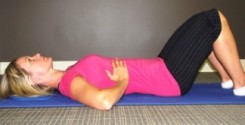Diaphragmatic breathing is one of the new buzz phrases surfacing aggressively these days. Why? What does it really mean? What is its importance to daily function and fitness?
What is the Diaphragm?
Well, the Diaphragm is the principle muscle involved with breathing. That alone is why we should be paying attention to it! The Diaphragm is a dome shaped muscle that separates the chest and abdominal cavities and attaches from the Xiphoid process (base of the sternum) all around inner surface of the 6 lower ribs and costal cartilages.
When relaxed, the dome rises up into rib cage, when we inhale that dome is pulled down toward the abdominal cavity which essentially makes the rib cage expand allowing the lungs to take in more air. Ideally, the expansion will be three dimensional with particular attention to the ribs moving out to the sides.
On the exhale, the dome releases back into the chest cavity, the rib cage collapses expelling the air out of the lungs as the ribs move closer together.
This is not the same as Belly Breathing where the abdominal wall expands forward (distention) and too little resistance is offered to the diaphragm which reduces the ability for it to contract efficiently.
Breathing and Back Pain
Often, poor breathing patterns accompany or contribute to low back pain, therefore the relationship of the Diaphragm to the rest of the core is an important one. The deep core, or more specifically the Inner Unit, is the complex grouping of specific muscles in the abdominal cavity that are responsible for stabilizing the lumbar spine and pelvis.
The muscles that form the Inner Unit are the Pelvic Floor, Multifidus, Transversus Abdominus, and the Diaphragm. As a unit, all aspects need to function normally to contribute to the overall success of the whole unit in order to provide optimal stability of the lumbo-pelvic region (or the low back and pelvis area).
Try This Exercise
A simple exercise you can do to focus on and feel the expansion of the rib cage is to lie on your back, knees bent with feet flat on floor, and your hands placed on the lower sides of your rib cage. Propping the head slightly on a towel or thin pillow will reduce the tension in the neck and upper back which will be key in allowing the rib cage to expand efficiently.

The sides and back of the ribs tend to be the more neglected areas of focus which is why we pay particular attention to those areas, plus this will help avoid a full distension of the belly and allow a subtle engagement of the deep abdominals to be maintained.
For some more information, here are a couple of articles :
http://hanslindgren.com/articles/diaphragm-function-for-core-stability/
http://www.peaksportsandspinept.com/articles/diaphragmaticBreathing.cfm
Of course, there are so many other benefits too for breathing efficiently. It promotes better oxygenation of the blood feeding and energizing the body, it helps to relax the tension out of your muscles, and has a grounding or calming effect thus lowering stress levels.
Don’t take a Breathing Exercise for granted. Approach it with as much importance as the desire to “feel the burn”. Your body and mind will work together and feel stronger.

